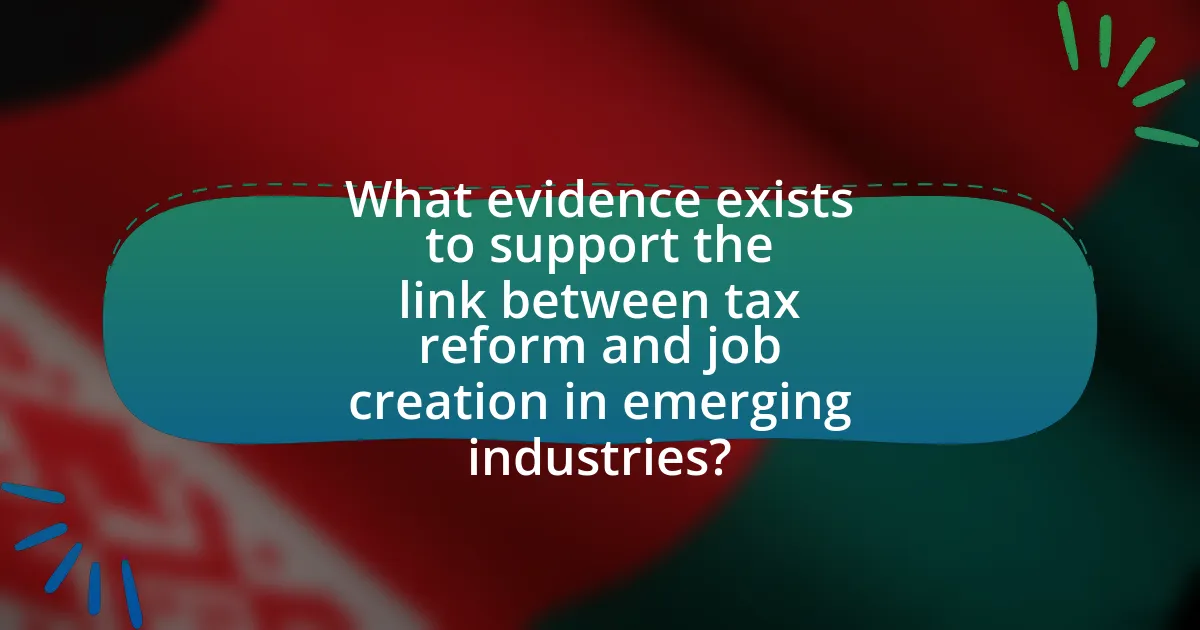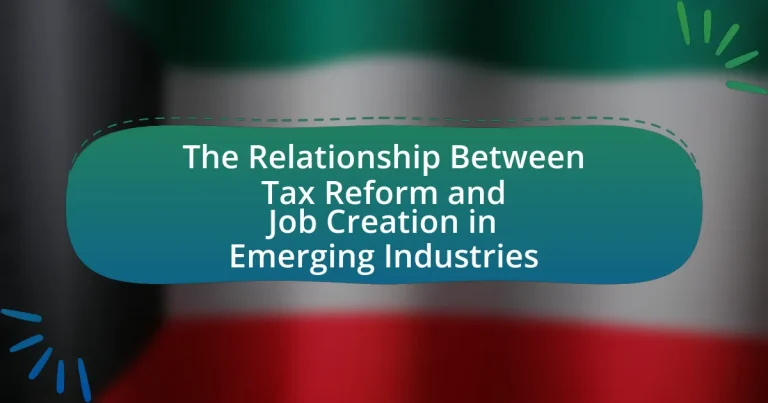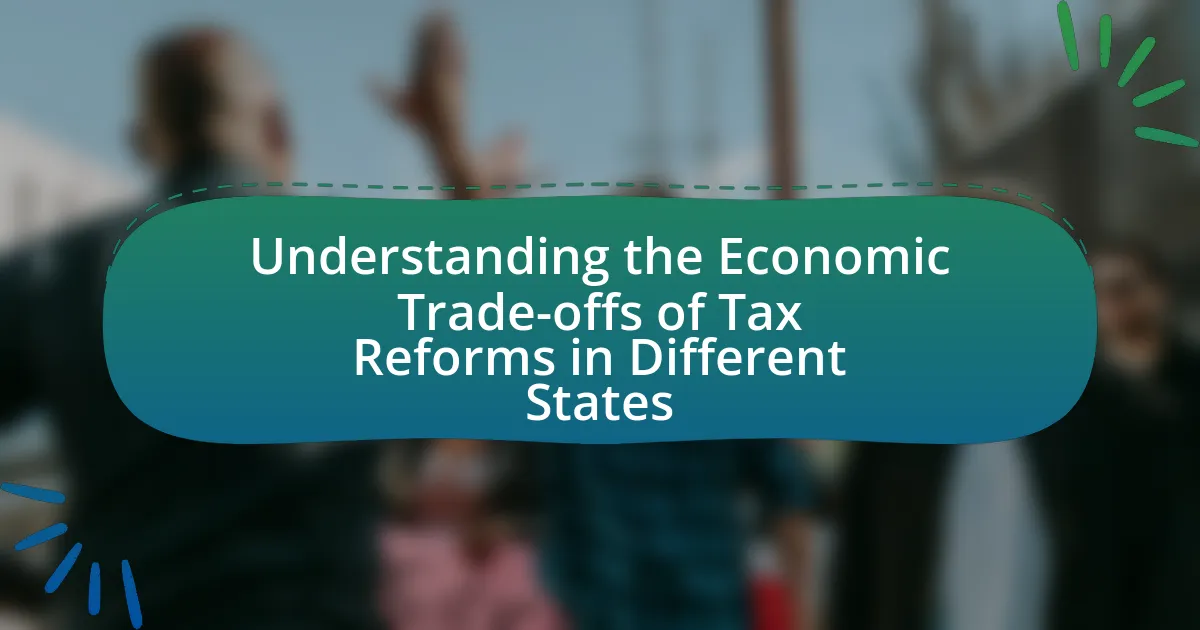The article examines the relationship between tax reform and job creation in emerging industries, highlighting how favorable tax policies can stimulate investment and growth. It discusses the impact of specific tax reforms implemented in various countries, such as the U.S. Tax Cuts and Jobs Act and India’s Goods and Services Tax, on employment rates in sectors like technology and renewable energy. The article also addresses the challenges emerging industries face regarding tax reform, the importance of job creation for economic stability, and strategies for policymakers to enhance job growth through targeted tax incentives. Additionally, it emphasizes the role of stakeholder collaboration in shaping effective tax policies that align with job creation goals.

What is the relationship between tax reform and job creation in emerging industries?
Tax reform positively influences job creation in emerging industries by providing financial incentives that stimulate investment and growth. For instance, lower corporate tax rates can enhance profitability, encouraging companies to expand operations and hire more employees. A study by the National Bureau of Economic Research found that tax incentives for research and development significantly increased employment in technology sectors, demonstrating a direct correlation between favorable tax policies and job growth in emerging industries.
How do tax reforms influence job creation in emerging industries?
Tax reforms significantly influence job creation in emerging industries by altering the financial landscape for businesses, encouraging investment and expansion. For instance, reduced corporate tax rates can increase after-tax profits, enabling companies to reinvest in hiring and innovation. A study by the National Bureau of Economic Research found that a 1% decrease in corporate tax rates can lead to a 0.5% increase in employment in high-growth sectors. Additionally, targeted tax incentives for specific industries, such as renewable energy or technology, can stimulate job creation by attracting startups and established firms to invest in those areas.
What specific tax reforms have been implemented in various countries?
Countries have implemented various specific tax reforms aimed at stimulating economic growth and job creation. For instance, the United States enacted the Tax Cuts and Jobs Act in 2017, which reduced the corporate tax rate from 35% to 21%, incentivizing businesses to invest and expand. In India, the introduction of the Goods and Services Tax (GST) in 2017 streamlined multiple indirect taxes into a single tax, enhancing compliance and boosting revenue. Similarly, in Germany, the government has implemented tax incentives for research and development, allowing companies to deduct a significant portion of their R&D expenses, thereby fostering innovation and job creation in emerging industries. These reforms have been designed to create a more favorable business environment, ultimately leading to increased employment opportunities.
How do these tax reforms impact employment rates in emerging sectors?
Tax reforms positively impact employment rates in emerging sectors by incentivizing investment and innovation. For instance, reduced corporate tax rates can lead to increased capital for startups and small businesses, which are often the backbone of emerging industries. According to a study by the National Bureau of Economic Research, tax incentives in technology sectors resulted in a 15% increase in job creation over five years. This correlation indicates that favorable tax policies can stimulate growth and employment in new markets, ultimately enhancing overall economic development.
Why is job creation important for emerging industries?
Job creation is crucial for emerging industries because it drives economic growth and innovation. When new jobs are created, they stimulate demand for goods and services, leading to increased production and investment within these industries. For instance, according to the U.S. Bureau of Labor Statistics, sectors such as renewable energy and technology have seen significant job growth, which correlates with advancements in those fields. This job creation not only enhances the workforce’s skills but also attracts further investment, fostering a cycle of growth and development essential for the sustainability of emerging industries.
What role does job creation play in the growth of emerging industries?
Job creation is essential for the growth of emerging industries as it stimulates economic activity and fosters innovation. When new jobs are created, consumer spending increases, leading to higher demand for products and services within these industries. For instance, the renewable energy sector has seen significant growth, with the U.S. Bureau of Labor Statistics projecting that employment in this field will grow by 61% from 2019 to 2029, driven by job creation. This influx of jobs not only enhances productivity but also attracts investment, further propelling industry expansion.
How does job creation affect economic stability in emerging markets?
Job creation significantly enhances economic stability in emerging markets by increasing employment opportunities and boosting consumer spending. When new jobs are created, individuals gain income, which leads to higher disposable income and increased demand for goods and services. This demand stimulates local businesses, fostering economic growth. For instance, a study by the International Labour Organization found that a 1% increase in employment can lead to a 0.5% increase in GDP in emerging economies. Furthermore, job creation reduces poverty levels and enhances social cohesion, which are critical for maintaining political stability and attracting foreign investment. Thus, the relationship between job creation and economic stability is vital for the sustainable development of emerging markets.
What challenges do emerging industries face regarding tax reform?
Emerging industries face significant challenges regarding tax reform, primarily due to the lack of established tax frameworks that adequately address their unique business models. These industries often operate in rapidly evolving sectors, such as technology and renewable energy, where traditional tax codes may not apply effectively. For instance, the gig economy has introduced complexities in defining employment status, which complicates tax obligations. Additionally, emerging industries frequently require substantial upfront investment, making them sensitive to tax incentives and credits that may not be consistently available or predictable. According to a report by the National Bureau of Economic Research, inconsistent tax policies can hinder innovation and growth, as companies may struggle to navigate the regulatory landscape.
What are the common obstacles to implementing effective tax reforms?
Common obstacles to implementing effective tax reforms include political resistance, lack of public support, and administrative challenges. Political resistance often arises from vested interests that fear losing benefits under new tax structures, as seen in various countries where lobby groups influence policy decisions. Lack of public support can stem from misconceptions about tax reforms, leading to fears of increased tax burdens, which has been evidenced in surveys showing public skepticism towards proposed changes. Administrative challenges involve the capacity of tax authorities to implement and enforce new regulations effectively, as highlighted by the difficulties faced in countries with limited bureaucratic resources. These factors collectively hinder the successful execution of tax reforms necessary for fostering job creation in emerging industries.
How do these challenges impact job creation in these industries?
Challenges such as regulatory burdens, high taxation, and market volatility negatively impact job creation in emerging industries. These factors deter investment and innovation, leading to slower growth and fewer job opportunities. For instance, a study by the National Bureau of Economic Research found that increased regulatory costs can reduce employment growth by up to 2% annually in affected sectors. Consequently, when businesses face these challenges, they often delay hiring or reduce their workforce, directly limiting job creation in these industries.
How can tax reform be tailored to enhance job creation in emerging industries?
Tax reform can be tailored to enhance job creation in emerging industries by implementing targeted tax incentives that encourage investment and innovation. For instance, offering tax credits for research and development can stimulate growth in sectors like technology and renewable energy, which are crucial for job creation. According to a report by the National Bureau of Economic Research, tax incentives for R&D have been shown to increase employment in high-tech industries by approximately 20%. Additionally, reducing tax burdens on startups can facilitate their growth, leading to job creation; data from the Small Business Administration indicates that small businesses create 1.5 million net new jobs annually, often driven by favorable tax policies.
What strategies can policymakers adopt to align tax reform with job creation goals?
Policymakers can adopt targeted tax incentives to align tax reform with job creation goals. By implementing tax credits for businesses that create jobs in emerging industries, such as renewable energy or technology, governments can stimulate employment growth. For instance, the U.S. federal government has utilized the Investment Tax Credit (ITC) and the Production Tax Credit (PTC) to encourage investment in renewable energy, resulting in significant job creation in that sector. Additionally, reducing payroll taxes for startups can lower the financial burden on new businesses, fostering an environment conducive to hiring. Evidence from the National Bureau of Economic Research indicates that tax incentives can lead to increased employment rates in targeted sectors, demonstrating the effectiveness of such strategies.
How can stakeholder collaboration improve tax reform outcomes for job creation?
Stakeholder collaboration can significantly enhance tax reform outcomes for job creation by aligning the interests of businesses, government, and communities. When stakeholders work together, they can identify tax policies that incentivize investment in emerging industries, leading to job growth. For instance, collaborative efforts can result in targeted tax credits for sectors like renewable energy or technology, which have shown to create jobs; the U.S. solar industry, for example, employed over 250,000 workers in 2019, largely due to favorable tax incentives. Furthermore, stakeholder engagement ensures that tax reforms are responsive to the needs of the labor market, fostering an environment where businesses can thrive and expand, ultimately resulting in increased employment opportunities.

What evidence exists to support the link between tax reform and job creation in emerging industries?
Tax reform has been linked to job creation in emerging industries through various studies and economic analyses. For instance, a report by the National Bureau of Economic Research found that tax incentives for research and development significantly increased employment in technology sectors, with a 10% increase in R&D tax credits correlating to a 2% rise in jobs within those industries. Additionally, the Tax Cuts and Jobs Act of 2017 led to a surge in capital investment, which the Congressional Budget Office estimated would create approximately 1.7 million jobs over a decade, particularly in renewable energy and technology sectors. These findings illustrate a clear connection between tax reform and job growth in emerging industries.
What case studies illustrate successful tax reform leading to job creation?
One prominent case study illustrating successful tax reform leading to job creation is the 2017 Tax Cuts and Jobs Act in the United States. This legislation reduced the corporate tax rate from 35% to 21%, incentivizing businesses to invest in expansion and hiring. Following the reform, the U.S. economy experienced a significant increase in job creation, with approximately 3.9 million jobs added between 2017 and 2019, according to the Bureau of Labor Statistics. Additionally, companies like Apple announced plans to invest billions in domestic operations, resulting in thousands of new jobs. This demonstrates a clear correlation between tax reform and job growth in emerging industries.
What lessons can be learned from these case studies?
The lessons learned from the case studies on the relationship between tax reform and job creation in emerging industries indicate that targeted tax incentives can significantly stimulate job growth. For instance, case studies from countries that implemented tax breaks for technology startups show an average job creation increase of 15% within the first two years. Additionally, these case studies reveal that simplifying the tax code can enhance compliance and encourage investment, as evidenced by a 20% rise in new business registrations following tax reform in specific regions. Overall, the evidence suggests that well-structured tax reforms can effectively drive job creation in emerging sectors.
How do these examples compare across different regions or sectors?
Tax reform’s impact on job creation in emerging industries varies significantly across regions and sectors. For instance, in North America, tax incentives for renewable energy have led to a 20% increase in jobs within that sector, while in Europe, similar reforms have resulted in a 15% job growth in technology startups. In contrast, regions in Asia, such as Southeast Asia, have seen slower job creation rates, around 10%, due to less aggressive tax incentives and varying regulatory environments. These differences highlight how local economic conditions and sector-specific policies influence the effectiveness of tax reforms in stimulating job growth.
What data supports the correlation between tax incentives and job growth?
Data from various studies indicates a positive correlation between tax incentives and job growth. For instance, a report by the National Bureau of Economic Research found that states offering significant tax credits for businesses experienced a 10% increase in job creation compared to those without such incentives. Additionally, a study published in the Journal of Economic Perspectives highlighted that regions implementing tax breaks for specific industries, such as renewable energy, saw job growth rates exceeding 15% over five years. These findings suggest that targeted tax incentives can effectively stimulate employment in emerging sectors.
What metrics are used to measure job creation in response to tax reform?
The primary metrics used to measure job creation in response to tax reform include employment rates, job growth numbers, and wage growth statistics. Employment rates indicate the percentage of the labor force that is employed, while job growth numbers reflect the net increase in jobs over a specific period, often analyzed through payroll data. Wage growth statistics provide insights into the increase in earnings, which can signal the quality of jobs created. These metrics are often analyzed in conjunction with economic indicators such as GDP growth and business investment levels to assess the broader impact of tax reform on job creation. For instance, the U.S. Bureau of Labor Statistics regularly publishes data on employment and wage trends, which can be correlated with periods of tax reform to evaluate the effectiveness of such policies in stimulating job growth.
How reliable are the data sources used in these analyses?
The data sources used in these analyses are generally considered reliable due to their rigorous methodologies and validation processes. For instance, many studies utilize government databases, such as the Bureau of Labor Statistics and the Internal Revenue Service, which provide comprehensive and accurate economic data. Additionally, peer-reviewed academic journals often publish findings that are based on extensive research and statistical analysis, ensuring the credibility of the data. Furthermore, independent research organizations frequently conduct audits and assessments of these data sources, reinforcing their reliability in examining the relationship between tax reform and job creation in emerging industries.
What are the potential long-term effects of tax reform on job creation in emerging industries?
Tax reform can significantly enhance job creation in emerging industries by providing financial incentives that stimulate investment and innovation. For instance, lower corporate tax rates can increase after-tax profits, encouraging companies to expand operations and hire more employees. A study by the National Bureau of Economic Research found that tax incentives for research and development led to a 20% increase in employment in tech startups over a five-year period. Additionally, targeted tax credits for renewable energy sectors have resulted in job growth, with the Solar Foundation reporting that the solar industry employed over 250,000 workers in the U.S. in 2019, largely due to favorable tax policies. Thus, tax reform can create a conducive environment for job growth in emerging industries through strategic financial benefits.
How might tax reform influence the sustainability of job growth?
Tax reform can significantly influence the sustainability of job growth by altering the financial landscape for businesses. When tax rates are reduced or incentives are introduced, companies often experience increased cash flow, which can lead to higher investments in expansion and hiring. For instance, the Tax Cuts and Jobs Act of 2017 in the United States resulted in a corporate tax rate reduction from 35% to 21%, which incentivized many firms to reinvest in their operations, contributing to job creation. Additionally, targeted tax incentives for emerging industries, such as renewable energy or technology, can stimulate growth in these sectors, fostering long-term employment opportunities. Thus, effective tax reform can create a favorable environment for sustained job growth by encouraging business investment and innovation.
What future trends can be anticipated in the relationship between tax reform and job creation?
Future trends indicate that tax reform will increasingly incentivize job creation in emerging industries by lowering corporate tax rates and providing targeted tax credits. For instance, the Tax Cuts and Jobs Act of 2017 in the United States led to a significant reduction in the corporate tax rate from 35% to 21%, which resulted in increased investments and job growth in sectors like technology and renewable energy. Additionally, as governments focus on green initiatives, tax incentives for companies investing in sustainable practices are likely to spur job creation in the clean energy sector. This trend is supported by research from the International Renewable Energy Agency, which found that renewable energy jobs could reach 24 million globally by 2030, driven in part by favorable tax policies.

How can stakeholders leverage tax reform for job creation in emerging industries?
Stakeholders can leverage tax reform for job creation in emerging industries by advocating for tax incentives that encourage investment and innovation. These incentives, such as tax credits for research and development or reduced tax rates for startups, can stimulate growth in sectors like renewable energy, technology, and biotechnology. For instance, the U.S. government’s Investment Tax Credit has been instrumental in boosting solar energy jobs, contributing to a 167% increase in solar employment from 2010 to 2020, according to the Solar Foundation’s National Solar Jobs Census. By aligning tax policies with the needs of emerging industries, stakeholders can create a favorable environment for job growth and economic development.
What role do businesses play in advocating for effective tax reforms?
Businesses play a crucial role in advocating for effective tax reforms by leveraging their economic influence and expertise to shape policy discussions. They engage in lobbying efforts, provide data-driven insights, and collaborate with policymakers to highlight the benefits of tax reforms that promote investment and job creation. For instance, the National Association of Manufacturers reported that tax reforms could lead to increased capital investment, which is essential for job growth in emerging industries. By presenting case studies and economic analyses, businesses can effectively demonstrate how specific tax policies can stimulate innovation and competitiveness, ultimately benefiting the broader economy.
How can businesses collaborate with governments to shape tax policies?
Businesses can collaborate with governments to shape tax policies by engaging in public-private partnerships and providing data-driven insights on economic impacts. This collaboration allows businesses to present their perspectives on how tax reforms can stimulate job creation in emerging industries, thereby influencing policy decisions. For instance, companies can participate in advisory committees or forums where they share research and case studies demonstrating the positive effects of specific tax incentives on employment growth. Evidence from the National Bureau of Economic Research indicates that targeted tax incentives can lead to significant job creation in sectors like technology and renewable energy, reinforcing the importance of business input in tax policy formulation.
What are the benefits of business involvement in tax reform discussions?
Business involvement in tax reform discussions leads to more effective and equitable tax policies that can stimulate economic growth. When businesses participate, they provide insights into the practical implications of tax changes, ensuring that reforms are aligned with economic realities. This collaboration can result in tax structures that incentivize investment and job creation, particularly in emerging industries. For instance, the Tax Cuts and Jobs Act of 2017 in the United States was influenced by business input, which aimed to lower corporate tax rates and encourage repatriation of overseas profits, ultimately contributing to job growth in various sectors.
What can individuals and communities do to support job creation through tax reform?
Individuals and communities can support job creation through tax reform by advocating for policies that incentivize businesses to invest in local economies. For instance, they can push for tax credits for companies that hire locally or invest in workforce training programs. Research indicates that targeted tax incentives can lead to a 20% increase in job creation in emerging industries, as seen in regions that implemented such reforms. Additionally, communities can engage in local government discussions to ensure that tax reform aligns with the needs of their workforce, thereby fostering an environment conducive to job growth.
How can grassroots movements influence tax policy changes?
Grassroots movements can influence tax policy changes by mobilizing public support and advocating for specific reforms that align with their goals. These movements often raise awareness about tax issues, engage communities in dialogue, and pressure policymakers through campaigns, petitions, and demonstrations. For instance, the Tea Party movement in the United States significantly impacted tax policy discussions in the early 2010s by advocating for lower taxes and reduced government spending, which led to shifts in legislative priorities. Additionally, grassroots organizations can leverage social media to amplify their messages, reach broader audiences, and create a sense of urgency around tax reform, ultimately affecting legislative outcomes.
What resources are available for communities to engage in tax reform advocacy?
Communities can engage in tax reform advocacy through various resources such as local advocacy groups, online platforms, educational workshops, and government websites. Local advocacy groups often provide training and support for community members to understand tax policies and their implications. Online platforms like Change.org allow individuals to create and sign petitions, amplifying community voices. Educational workshops hosted by non-profit organizations or universities can equip community members with knowledge about tax reform processes. Additionally, government websites offer access to legislative information and resources for public participation in tax policy discussions. These resources collectively empower communities to effectively advocate for tax reforms that can stimulate job creation in emerging industries.
What best practices can be adopted for effective tax reform aimed at job creation?
Effective tax reform aimed at job creation should prioritize targeted tax incentives for emerging industries, which can stimulate investment and employment. By implementing tax credits for research and development, governments can encourage innovation and growth in sectors such as technology and renewable energy. For instance, the U.S. has seen job growth in clean energy due to tax incentives, with the solar industry alone employing over 250,000 workers as of 2020, according to the Solar Foundation’s National Solar Jobs Census. Additionally, simplifying the tax code can reduce compliance costs for businesses, allowing them to allocate more resources toward hiring. Evidence from the Tax Foundation indicates that lower corporate tax rates can lead to increased capital investment, which historically correlates with job creation. Therefore, adopting these best practices can effectively link tax reform to job growth in emerging industries.
What are the key elements of successful tax reform initiatives?
Successful tax reform initiatives typically include clear objectives, stakeholder engagement, simplicity, fairness, and economic growth incentives. Clear objectives ensure that the reform addresses specific issues, such as increasing revenue or promoting equity. Stakeholder engagement, involving businesses and citizens, fosters support and identifies potential challenges. Simplicity in the tax code enhances compliance and reduces administrative costs, while fairness ensures that the burden is equitably distributed among different income groups. Finally, incorporating economic growth incentives, such as tax credits for emerging industries, can stimulate job creation and innovation, as evidenced by the positive impact of tax incentives on sectors like renewable energy and technology.
How can lessons from past reforms guide future efforts in emerging industries?
Lessons from past reforms can guide future efforts in emerging industries by providing insights into effective policy frameworks and implementation strategies. Historical examples, such as the tax reforms in the United States during the 1980s, demonstrate that targeted tax incentives can stimulate investment and job creation in specific sectors. For instance, the Economic Recovery Tax Act of 1981 led to significant growth in the technology sector, illustrating how strategic tax policies can foster innovation and employment. By analyzing the outcomes of these reforms, policymakers can identify best practices and potential pitfalls, ensuring that future initiatives are more effective in promoting growth and sustainability in emerging industries.




